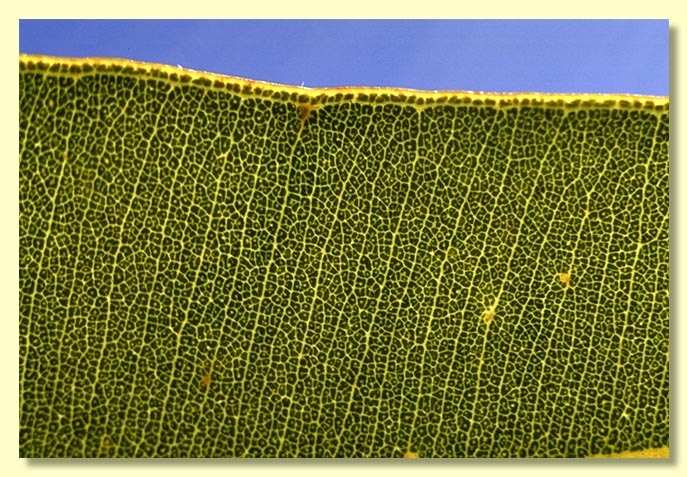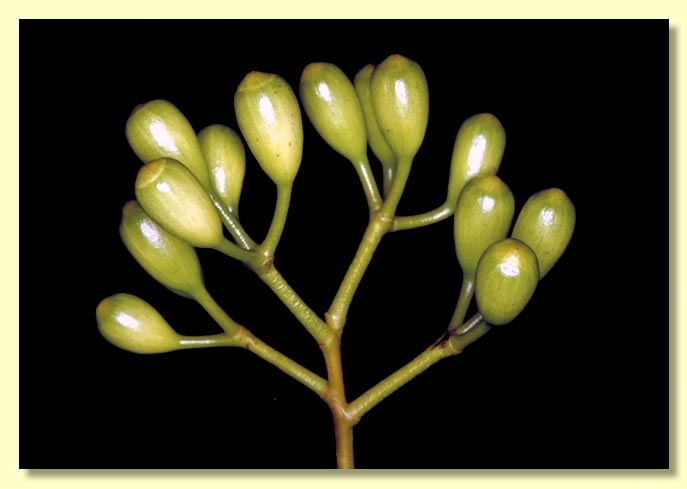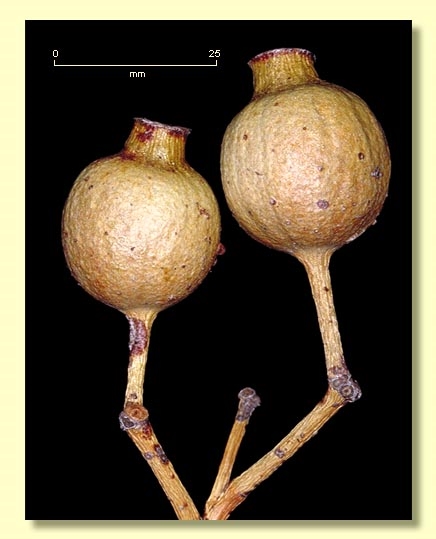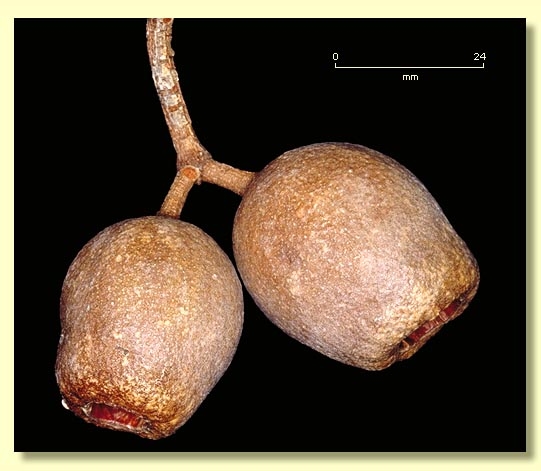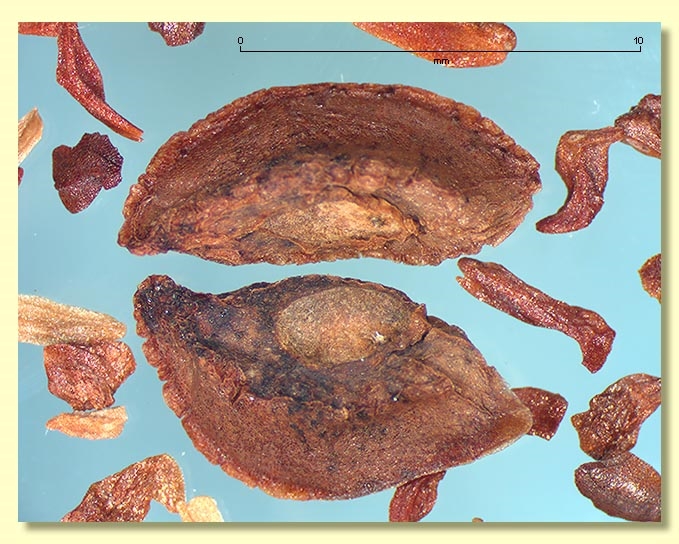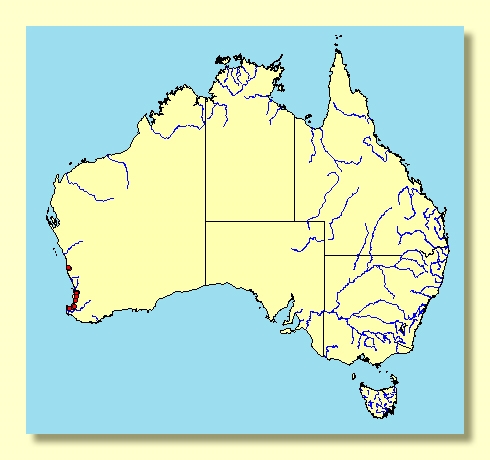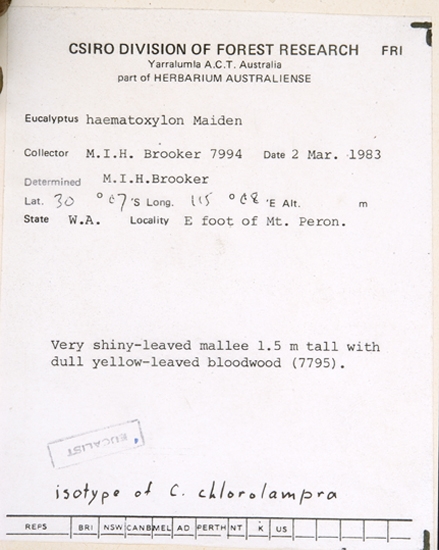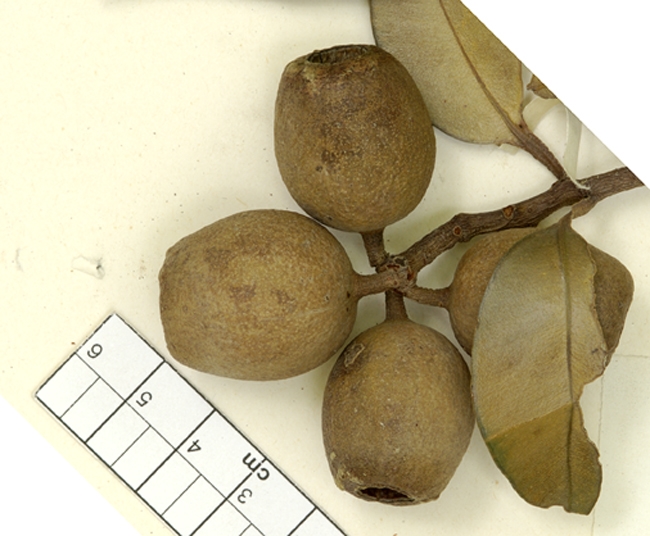Euclid - Online edition
Corymbia haematoxylon
Corymbia | Rufaria
Bark rough to the small branches, tessellated, pale grey-brown to yellow-brown, yellow to orange on freshly broken surfaces.
Branchlets lacking oil glands in the pith.
Juvenile stems round in cross-section, scabrid on the lower portion of stem; juvenile leaves below node 8, petiolate, opposite for few nodes then alternate, ovate to broadly lanceolate, scabrid, base peltate; after node 8, petiolate, broadly lanceolate, base tapering to the petiole, semi-glossy green.
Adult leaves alternate, petioles (1)1.2–2.5(3) cm long; blade lanceolate to narrowly ovate, (5.5)7–12(14) cm long, (1.7)2–3.5(4) cm wide, flat to slightly undulate, discolorous, glossy to slightly glossy or somewhat dull green darker above, paler below, base tapering to the petiole (sometimes almost rounded), margin entire, apex acute, side-veins strongly penniveined, reticulation very dense, intramarginal vein present but close to the leaf margin, oil glands island.
Inflorescence terminal compound, peduncles (1)1.2–2(3) cm long, buds 7 per umbel, pedicels 0.4–1.3 cm long. Mature buds oblong to obovoid, 0.6–1.1 cm long, 0.4–0.7 cm wide, surface smooth (not scurfy), scar absent (both opercula shed together at flowering), operculum flattened, stamens inflexed, anthers oblong, versatile, dorsifixed, dehiscing by longitudinal slits, style long and straight, stigma papillate (mop-like), locules commonly 3 (occasionally 4), ovules not in regular vertical rows. Flowers white.
Fruit pedicellate (pedicels 0.4–1.3(1.7) cm long), urceolate (rarely truncate-ovoid to truncate-globose), 1.5–3.6 cm long, 1.2–2.7 cm wide, neck conspicuous and erect or almost absent, disc vertically descending, valves 3 (occasionally 4), deeply enclosed.
Seeds dull to semi-glossy, red-brown to brown, (8)10–12 mm long, more or less elongated boat-shaped, wing absent but with a narrow scarious flange on the dorsal keel, hilum ventral.
Cultivated seedlings (measured at node 10): cotyledons reniform to orbicular; stems round in cross-section, scabrid to ca node 6; leaves petiolate, opposite for the first 3 nodes then alternate, broadly lanceolate to ovate, 6.3–14 cm long, 2.8–4.8 cm wide, dull green at first but becoming semi-glossy at ca node 10, base peltate to ca node 10 then base tapering to the petiole; lamina scabrid till ca node 8.
Flowering has been recorded in February and March.
A small tree or rarely mallee mostly distributed south of Perth on the western side of the Darling Range from Byford to Capel, and a small occurrence north of Perth near Mt Lesueur. Corymbia haematoxylon has rough bark, tessellated throughout. The adult leaves are strongly discolorous, darker green above, paler below, with very numerous, wide-angled side-veins and with small island oil glands. The inflorescences are terminal and compound, the flowers white and the seeds red-brown and wingless. Fruit is usually urceolate with a small orifice but varies considerably in the development of the neck, and adjacent trees may differ strongly in this regard while otherwise being similar in leaf, bud and seed features.
C. haematoxylon is one of three species of bloodwood found in the south-west of Western Australia. The much more widespread and common C. calophylla differs by the much taller habit, larger buds and fruit (fruit width usually greater than 2.5 cm in C. calophylla and less than 2.5 cm in C. haematoxylon), fruit with a wider orifice than in C. haematoxylon, and the black wingless seeds (red-brown in C. haematoxylon). The third species, C. ficifolia, has a very restricted distribution in the Walpole, Mt Frankland, Albany and Stirling Range area near the south coast of Western Australia, and differs by the lack of visible oil glands in the leaves (usually), the brilliant red or orange flowers, the winged seeds and rough, but less clearly tessellated bark.
The Mt Lesueur form of C. haematoxylon was described as a separate species and published as C. chlorolampra. It has somewhat glossy leaves but cannot be easily distinguished from the southern population, which can also have semi-glossy leaves, and is here regarded as being synonymous with C. haematoxylon.
Intermediate forms between C. calophylla and C. haematoxylon do occur, particularly in the northern population around Mt Lesueur.
MORE ABOUT CORYMBIA
MORE ABOUT RED BLOODWOODS




